Old French Kansas City Historical Marker
Introduction
Text-to-speech Audio
Kansas City was first officially incorporated as a town in 1850, but for several decades prior it had been an area of settlement for Frenchmen. Traders in St. Louis and along the Mississippi River had long used the Missouri River as a westward route to trade goods with the Native Americans. Kansas City sits at the confluence of the Missouri and Kansas Rivers and is a natural crossroads of traffic, making it ideal for settlement. French people's presence in the region long outlasted the French state's presence which mostly left by 1763.
Images
English side of the marker, courtesy of Thomas Onions
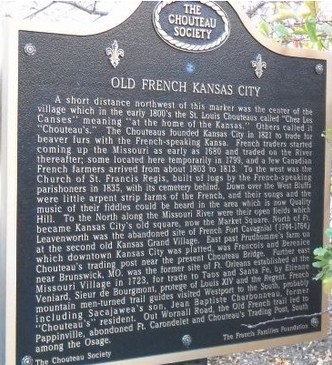
French side of the marker, courtesy of Thomas Onions
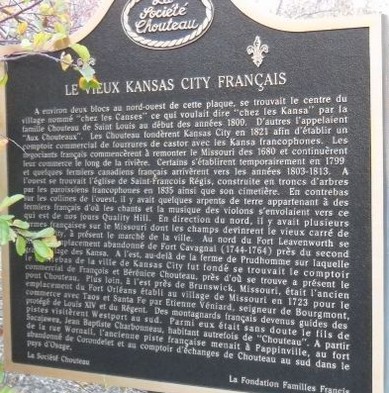
French colonial territory
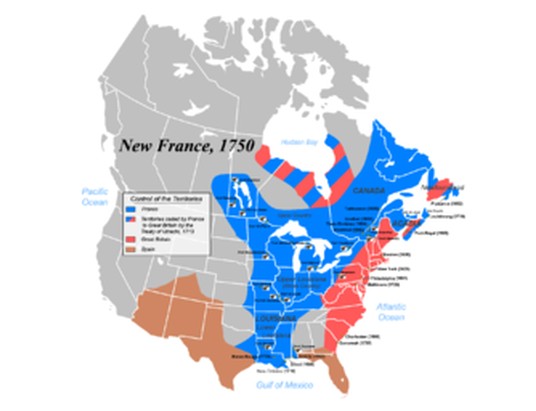
Francois Chouteau
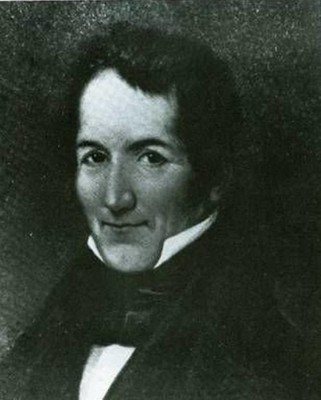
Contemporary drawing by Nicholas Point showing the location of the Chez Le Canses families
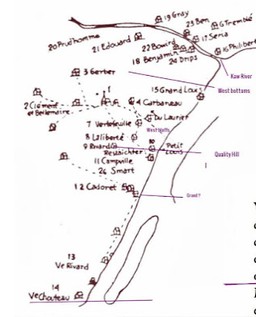
Backstory and Context
Text-to-speech Audio
Long before Kansas City was a bustling midwestern American metropolis, it was a frontier area for the colonizing French monarchy. Settlements like Fort de Cavagnial and Fort Orleans were set up deep into the Missouri Territory to serve multiple functions as military outposts and trading centers. Commandant of Missouri River Étienne de Veniard Sieur de Bourgmont, had command of Fort Orleans until its closure in 1726 and Fort de Cavagnial was largely run by Frenchmen like Joseph Deruisseau, who cornered the fur trade for France in their respective areas. These Frenchmen were well known for their skilled outdoorsmanship and negotiating abilities. This official French presence in Missouri vanished after the Louisiana Territory was ceded to Spain in 1762 in wake of the Seven Years War.
The exit of the French crown was hardly the last Missouri had seen of the French presence. Most of the French nationals living out in the frontier of the Louisiana Territory remained, despite the change in the rulership over their land. The French fur traders, like the Chouteau family, had developed many close business relationships with various local Native American people groups and they continued to use these relationships to their advantage well into the nineteenth century. The Chouteau's became valuable U.S. Citizens after the Louisiana Purchase in 1803 and were very influential in America’s westward expansion. They provided supplies and personnel to the Lewis and Clark expedition and continued to facilitate trade between St. Louis and Native Americans.
Francois Chouteau is largely credited as the founder of Kansas City for his efforts in establishing trading posts along the Kansas and Missouri rivers near their confluence in the 1820’s. Much of Kansas City’s earliest residential developments occurred under his watch. Frenchmen had already been living in the area for a few decades and some among them quickly found employment in Chouteau’s trading ventures. The original village and trading posts have all been washed away by nineteenth century floods and little physical evidence remains of them.
The text of this historical marker reads as follows:
A short distance northwest of this marker was the center of the village which in the early 1800's the St. Louis Chouteau called "Chez Lez Canses"" meaning "at the home of the Kansas." Others called it "Chouteau's." The Chouteau's founded Kansas City in 1821 to trade for beaver furs with the French-speaking Kansa. French traders started coming up the Missouri as early as 1680 and traded on the River thereafter; some located here temporarily in 1799, and a few Canadian French farmers arrived here about 1803 to 1813. To the west was the Church of St. Francis Regis, built of logs by the French-speaking parishioners in 1835, with its cemetery behind. Down over the West Bluffs were little arpent strip farms of the French, and their songs and the music of their fiddles could be heard in the area which is now Quality Hill. To the North along the Missouri river were their open fields which became Kansas City's old square. North of Ft. Leavenworth was the abandoned site of Fort Cavagnal (1744-1764) at the second old Kansas Grand Village. East past Prudhumme's farm which downtown Kansas City was platted, was Francois and Berenice Chouteau's trading post near the present Chouteau Bridge. Further east near Brunswick, Mo., was the former home of Ft. Orleans established at the Missouri Village in 1723, for trade with Taos and Santa Fe, by Etienne Veniard, Sieur de Bourgmont, protege of Louis XIV and the Regent. French mountain men-turned trail guides visited Westport to the South, probably including Sacajawea's son, Jean Baptiste Charbonneau, former "Chouteau's" resident. Out Wornall Road, the Old French trail led to Pappinville, abandoned Ft, Carondelet and Chouteau's Trading Post, South among the Osage.
Cite This Entry
Allen, Charles and Nichole Stahly. "Old French Kansas City Historical Marker." Clio: Your Guide to History. August 15, 2022. Accessed March 26, 2025. https://theclio.com/tour/573/16
Sources
Old French Kansas City, The Historical Marker Database. Accessed July 28th, 2022. https://www.hmdb.org/m.asp?m=86214.
Hoig, Stan. The Chouteaus First Family of the Fur Trade. University of New Mexico Press, 2008.
Gayarré, Charles. History of Louisiana: The French Domination. Volume 2. New York. Redfield, 1854.
Chez les Canses: Chouteau's Town Before Kansas City, The New Santa Fe Trailer. July 31st, 2019. Accessed August 8th, 2022. https://newsantafetrailer.blogspot.com/2019/07/chez-les-canses-chouteaus-town-before.html.
https://www.hmdb.org/m.asp?m=86214
https://www.hmdb.org/m.asp?m=86214
http://dsullivanadaircountyr1.weebly.com/missouri-unit-four-arrival-of-europeans.html
https://alchetron.com/Fran%C3%A7ois-Chouteau#franois-chouteau-f9676610-fe6f-4bbc-a6f1-584363af831-resize-750.jpeg
https://newsantafetrailer.blogspot.com/2019/07/chez-les-canses-chouteaus-town-before.html

